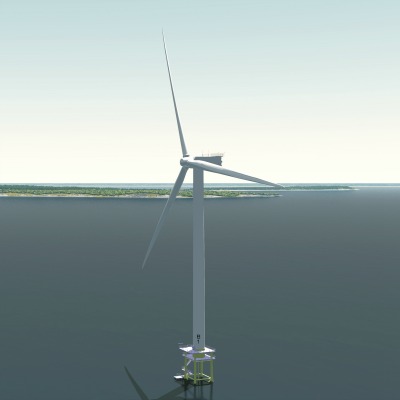 Jeff Grybowski, Deepwater Wind's chief executive officer, says the offshore wind developer has moved well beyond the early stages of development and is now squarely focusing on completing the 30 MW Block Island Wind Farm, located off the coast of Block Island, R.I.
Jeff Grybowski, Deepwater Wind's chief executive officer, says the offshore wind developer has moved well beyond the early stages of development and is now squarely focusing on completing the 30 MW Block Island Wind Farm, located off the coast of Block Island, R.I.
‘We see a clear path to finalizing the contracts to start building the project,’ notes Grybowski, who sat down with NAW during the American Wind Energy Association's (AWEA) Offshore Windpower 2013 Conference & Exhibition, recently held in Providence. ‘Right now, we're in execution mode.’
He says construction activities will begin in late 2014, beginning with the ‘transmission piece of the project,’ which includes a 21-mile, medium-voltage submarine cable connecting the offshore wind farm to the mainland. Although details have yet to be finalized, Deepwater says the subcable will make landfall in Narragansett, R.I.
The jacket foundations will begin arriving in spring 2015, with Siemens delivering five 6 MW direct-drive turbines that summer and grid completion expected in the fall. That time frame would make Deepwater's Block Island Wind Farm among the first, if not the first, offshore wind farm in the U.S.
National Grid has agreed to buy the project's output, making Deepwater one of two U.S. offshore wind developers to secure a power purchase agreement. (Cape Wind Associates has two contracts to sell 77.5% of the output generated by its planned 468 MW project.)
With the focus on project completion, Grybowski says the company's top priority is ensuring that Deepwater is able to satisfy the 5% safe-harbor provision to qualify for the investment tax credit. Among other requirements, developers must incur 5% of the project's cost by Dec. 31 to be eligible for the tax incentive.
To satisfy the U.S. Treasury's 5% spend threshold, Deepwater plans to use a combination of ‘historical expenditures’ and contracts signed with vendors until the end of the year.
Declining to delve into specifics, Grybowski notes such expenses could include turbine components, installation vessels or other components related to construction.
Because the Treasury approves (or rejects) applications after the project is completed, Deepwater will leave nothing to interpretation, Grybowski says, indicating the company will spend well in excess of the 5% threshold. Deepwater has already spent more than $30 million developing the Block Island site.
‘You don't want to get to the end of the project and learn that Treasury says you only spent 4.8 percent [of the project's total cost],’ he notes, ‘because then you'll get nothing.’
While its focus is on completing Block Island, Deepwater is already working toward advancing the Deepwater Wind Energy Center (DWEC), a proposed 1 GW-scale offshore wind farm located in federal waters.
The project is planned for the lease block awarded to Deepwater as part of the Bureau of Ocean Energy Management's Rhode Island/Massachusetts auction. On July 31, Deepwater bid $3.8 million for two parcels totaling 164,000 acres in a designated Wind Energy Area on the Outer Continental Shelf.
Grybowski says the DWEC's 200 or so turbines will be located 20 to 25 miles from land.
Although the 1 GW-scale project is clearly more ambitious than Block Island demonstration project, Grybowski is encouraged that much of the heavy lifting associated with spatial marine planning and site evaluation has already been completed by the Rhode Island Coastal Resources Management Council (CRMC).
The CRMC's work on the Rhode Island Ocean Special Area Management Plan (SAMP) -ostensibly a zoning plan for the ocean – provides a means for not only protecting the marine environment, but also a framework for policy development. The CRMC-led project provides Deepwater a three- to five-year scheduling head-start. "That's a big advantage.’
Further, Grybowski explains, the same agencies – in some cases, the same people – that approved Deepwater's Block Island demonstration project are charged with vetting the DWEC.
‘However, we still need a permit for that site,’ he notes. ‘But we're highly confident we can get it done.’
Photo: A rendering of a wind turbine at the Block Island site. Photo courtesy of Deepwater Wind.



